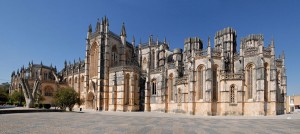During the night and throughout the next day, as many as 5000 more Castilians were killed by the neighbouring towns’ villagers; according to Portuguese tradition surrounding the battle, there was a woman called Brites de Almeida, the Padeira of Aljubarrota (the baker-woman of Aljubarrota), said to be very tall, strong, and to possess six fingers on each hand, who ambushed and killed by herself eight Castilian soldiers as they were hiding in her bakery trying to save their lives after the battle in the town of Aljubarrota. This story is clouded in legend and hearsay. But the popular intervention in the massacre of Castilian troops after the battle is, nevertheless, historical and typical of battles in this period when there was no mercy toward the defeated enemy.
On the morning of the following day, the true dimension of the battle was revealed: in the field, the bodies of Castilians were enough to dam the creeks surrounding the small hill. In face of this, the Portuguese King offered the enemy survivors an amnesty and free transit home; an official mourning was decreed in Castile that would last until the Christmas of 1387. The French cavalry contingent suffered yet another defeat (after Crécy and Poitiers) by English defensive tactics, even though they finally defeated the English and unified their country after the 100 years war.
In October 1385, Nuno Álvares Pereira led a pre-emptive attack against Mérida, in Castilian territory, defeating an even larger Castilian army than at Aljubarrota in the battle of Valverde, in Valverde de Mérida. Scattered border skirmishes with Castilian troops would persist for five years more until the death of John I of Castile in 1390, but posed no real threat to the Portuguese crown; recognition from Castile would arrive only in 1411 with the signature of the Treaty of Ayllón (Segovia).
This victory assured that John of Aviz was the uncontested King of Portugal and the House of Aviz ascended to the crown of Portugal. In 1386, the closeness of relations between Portugal and England resulted in a permanent military alliance with the Treaty of Windsor, the eldest still active in existence.
His marriage to Philippa of Lancaster in 1387 initiated the Portuguese second dynasty, and their children went on to make historically significant contributions. Duarte, or Edward of Portugal, became the eleventh King of Portugal known as “The Philosopher” and “The Eloquent”, and his brother Henrique, or Henry the Navigator, sponsored expeditions to Africa.
In commemoration of the Battle of Aljubarrota the Portuguese erected the Monastery of Saint Mary of the Victory (Portuguese: “Mosteiro de Santa Maria da Vitória”) one of the best and original examples of Late Gothic architecture in Portugal, intermingled with the Manueline style.
In 1393 a chapel in honor of St. Mary and St. George was erected in the place where had been the standard of D. Nuno Alvares Pereira during the confrontation allowing us to know the precise geographic location of the confrontation site.
In 1958 archeologist Afonso do Paço organized the first campaign of excavations, revealing the complex defensive system consisting about 800 pits and dozens of defensive ditches and revealing one of the best preserved battlefields of the Hundred Years’ War.
In March 2002, under the initiative of António Champalimaud The Foundation Batalha de Aljubarrota was created. The Foundation began its activity by recovering the battlefield of Aljubarrota. Through a Protocol established with the Ministry of Defense, in August 2003, the Foundation received authorization to transform the Military Museum into a modern Interpretation Center of the Battle of Aljubarrota. This Interpretation Center was inaugurated in October 11, 2008.
On December 28, 2010, the Portuguese Official Journal published the Decret-Law n.º 18/2010, which states the legal recognition of the battlefield of Aljubarrota with the category of “national monument”.




Comments are closed.